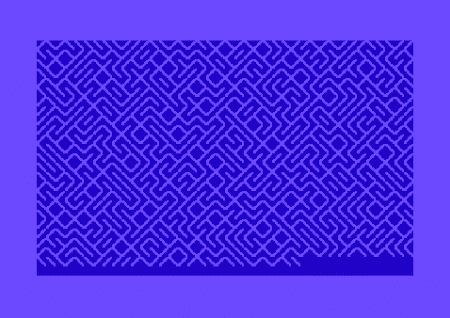Groups on Linear Spaces
In physical mathematics we frequently speak of group operations on linear spaces. Consider the elements of a group ${G_a}$ and linear operators $T(G_a)$, so that $T(G_a)v \implies v'$, where $v$ and $v'$ are vectors.\begin{align}
T(G_a) e_i &= T_{ji}(G_a) e_j \\
(e_j, T(G_a) e_i) &= T_{ji}(G_a) \\
T(G_a) T(G_b) &= T(G_c) \text{, if $ G_a G_b = G_c$}
\end{align}
The operators $T$ are an example of a representation of the group ${G_a}$ with respect to operator multiplication.
What is a group?
We restrict attention to finite groups, which are sets with a binary operation that is
$\require{enclose}$1. closed, and
2. associative
Also,
3. $\exists$ an inverse for every element, and
4. $\exists$ an identity element
Reducibility
This is an important topic in rep theory. Suppose L is a vector space, invariant with respect to the transformations $T(G_a)$. If $L=L_1 + L_2$, two orthogonal spaces also invariant with respect to $T(G_a)$, then T reduces. Otherwise, $T$ is irreducible. Amazing fact: all finite groups have a finite number of (non-equivalent) irreducible representations. We will show this.Schur's Lemma
Before going further, we need a preliminary result.$$
T^{\alpha}(G_a) A - A T^{\beta}(G_a) = 0 \; \enclose{horizontalstrike}{\lor} \;G_a \implies A = \lambda \delta_{\alpha \beta} I
$$
But we can construct just such an $A$
$$
A = \sum_b T^{\alpha} (G_a) X T^{\beta}(G_a^{-1})
$$
$X$ is arbitrary, but determines $\lambda$
$$
\sum_{bmn} T_{im}^{\alpha}(G_b) X_{mn} T_{nj}^{\beta}(G_b^{-1}) = \lambda \delta_{\alpha \beta} \delta_{ij}
$$
Choose $X_{mn} = \delta_{mq}\delta_{np}$
\begin{equation}
\sum_{b} T_{iq}^{\alpha}(G_b)T_{pj}^{\beta}(G_b^{-1}) = \lambda \delta_{\alpha \beta} \delta_{ij} \label{eq:1}
\end{equation}
Let $\alpha = \beta$ and $i=j$
$$
\sum_{b} T_{iq}^{\alpha}(G_b)T_{pi}^{\beta}(G_b^{-1}) = \lambda
$$
Sum both sides over $i$
$$
\sum_{b} T_{pq}^{\alpha}(E) = \lambda S_{\alpha}
$$
$ S_{\alpha}$ is the dimension of the $\alpha$ representation.
\begin{equation}
g \delta_{pq} = \lambda S_{\alpha} \label{eq:2}
\end{equation}
$g$ is the number of elements in the group.
Using $\eqref{eq:2}$ in $\eqref{eq:1}$:
\begin{equation}
\sum_{b} T_{iq}^{\alpha}(G_b)T_{pj}^{\beta}(G_b^{-1}) = \delta_{pq} \delta_{\alpha \beta} \delta_{ij} \frac{g}{S_{\alpha}} \label{eq:3}
\end{equation}
Let $T$ be unitary, $i=j$, $\alpha = \beta$, and $p = q$.
\[
\sum_{b} T_{iq}^{\alpha}(G_b)T_{iq}^{* \alpha}(G_b) = \sum_{b}{|T_{iq}^{\alpha}(G_b)|}^2 = \frac{g}{S_{\alpha}}
\]
Characters
In $\eqref{eq:3}$, let $q=i$ and $p=j$ and sum over $i$ and $j$\begin{align*}
\sum_{ijb} T_{ii}^{\alpha}(G_b) T_{jj}^{* \beta}(G_b) & = \sum_{ij} \delta_{ij} \frac{g}{S_{\alpha}} \delta_{\alpha \beta} \\
\sum_{b} \chi^{\alpha}(G_b) \chi^{* \beta}(G_b) &= g \delta_{\alpha \beta}
\end{align*}
Where the character $\chi^{\alpha}(G_a)$ is the trace of the operator $T^{\alpha}(G_a)$
If we let $C_p$ count the members of a given class, the elements of which share a character, we can write this as
\begin{align}
\sum_p C_p \chi_p^{\alpha} \chi_p^{* \beta} &= g \delta_{\alpha \beta} \label{eq:4} \\
\sum_p C_p |\chi_p|^2 &= g
\end{align}
For any representation, $\chi_p = \sum_i m_i \chi_p^i$ since any rep can be resolved to its irreducible components. We can find the $m_i$, given the characters.
\begin{align*}
\sum_p C_p \chi_p^{\alpha} \chi_p &= \sum_i \sum_p C_p \chi_p^{\alpha} m_i \chi_p^i \\
&= \sum_i g \delta_{\alpha i} m_i \\
&= m_\alpha g
\end{align*}
For any rep, $\sum_p |\chi_p|^2 \gt g$ with equality only if the rep is irreducible.
\begin{align}
\sum_p |\chi_p|^2 &= \sum_p C_p \sum_{\alpha} m_\alpha \chi_p^\alpha \sum_{\beta} m_\beta \chi_p^\beta \\
&= \sum_{\alpha \beta} \sum_p C_p \chi_p^\alpha \chi_p^{* \beta} m_\alpha m_\beta \\
&= \sum_{\alpha \beta} \sum_p g \delta_{\alpha \beta} m_\alpha m_\beta \\
&= \sum_\alpha g |m_\alpha|^2
\end{align}
This equals $g$ only if the $m_\alpha$ are all $0$, with one exception, which is $1$
The Regular Representation
Define the $g$-dimensional representation $T^\text{Regular}$ by
$$
G_a G_b = \sum_c T_{cb}^\text{Regular}(G_a) G_c
$$
The $\chi^R(G)$ are all zero except $\chi^R(E)$ which is $g$. Consider the reduction of the regular representation:
\begin{align}
\sum_p C_p \chi_p^{* \alpha} \chi_p^R &= g m_\alpha \\
C_E \chi_E^{* \alpha} \chi_E^R(E) &= g m_\alpha \\
S_\alpha g &= g m_\alpha
\end{align}
So $m_\alpha = S_\alpha$, and $g=\sum_\alpha m_\alpha S_\alpha = \sum_\alpha S_\alpha^2$
The number of orthogonal vectors, $T_{ij}^\alpha$, is $\sum_\alpha S_\alpha^2$, which we now know is $g$. That is, these vectors span the vector space. We could expand any vector in this space as
$$
v = \sum_{ij\alpha} Z(ij\alpha) T_{ij}^\alpha
$$
Or in component form
$$
v_a = \sum_{ij\alpha} Z(ij\alpha) T_{ij}^\alpha(G_a)
$$
Character Relations
Now, consider a vector $v$ that has the same component along all directions in a class, like so:$$
v_a = \frac {1}{g} \sum_{b=1}^g v_c \,\,\, \text{ where $G_c = G_b^{-1} G_a G_b$}
$$
and decompose $v_a$ and $v_c$ along $T$ like so:
\begin{align}
v_c &= \sum_{ij\alpha} Z(ij\alpha) T_{ij}^\alpha(G_c) \\v_a &= \sum_{b} \sum_{ij \alpha} \sum_{kl} \frac{Z(ij\alpha)}{g} T_{ik}^\alpha(G_b^{-1}) T_{kl}^\alpha(G_a) T_{lj}^\alpha(G_b)
\end{align}
Using $\eqref{eq:3}$ to sum out $b$
\begin{align}
v_a &= \sum_{ij \alpha} \sum_{kl} \frac {Z(ij\alpha)}{g} \frac{g}{S_\alpha} \delta_{kl} \delta_{ij} T_{kl}^{\alpha}(G_a) \\
&= \sum_{i\alpha} \sum_k \frac{Z(ii\alpha)}{S_\alpha} T_{kk}^{\alpha}(G_a) \\
&= \sum_{i\alpha} \frac{Z(ii\alpha)}{S_\alpha} \chi^{\alpha}(G_a) = \sum_{\alpha} \chi^{\alpha}(G_a) \left[ \sum_i \frac{Z(ii\alpha)} {S_\alpha} \right] = \sum_\alpha z(\alpha) \chi^\alpha(G_a)
\end{align}
We see that the $\chi^\alpha$ span this space of classes so we conclude there must be $n$ $\alpha$'s if there are $n$ classes.
\[
\bbox[5px,border:2px solid red]
{
\text{# of irreps = # of classes}
}
\]
Since the character table is square, we can re-write $\eqref{eq:4}$, which tells us the rows of the table are orthogonal, in the following form
$$
B_{\alpha p} = \sqrt{\frac{C_p}{g}} \chi_p^\alpha
$$
$$
\sum_p B_{\alpha p} B_{\beta p}^{*} = \delta_{\alpha \beta}
$$
So $Det(B) = Det(B^{\dagger}) = 1$, so $B$ has an inverse, $B^{-1} = B^{\dagger}$, which implies the columns are also orthogonal:
$$
\sum_{\alpha} B_{\alpha p}^{*} B_{\alpha q} = \delta_{pq}
$$
$$
\sum_{\alpha} \frac{C_p }{g} \chi_p^{\alpha *} \chi_q^{\alpha} = \delta_{pq}
$$
\begin{equation}
\sum_\alpha \chi_p^\alpha \chi_q^\alpha = \frac{g}{C_p} \delta_{pq}
\end{equation}
Woo!
Projection Operators
$$G_a e_i^{\alpha} = \sum_j T_{ji}^\alpha(G_a) e_j^{\alpha} \, \text { (defines a representation) }
$$
\begin{align}
\sum_a T_{mn}^{\beta}(G_a^{-1}) G_a e_i^\alpha &= \sum_{aj} T_{mn}^{\beta}(G_a^{-1}) T_{ji}^\alpha(G_a) e_j^\alpha \\
&= \sum_j \frac{g}{S_\beta} \delta_{mi} \delta_{nj} \delta_{\alpha \beta} e_j^{\alpha} \\
&= \frac{g}{S_\beta} \delta_{mi} \delta_{\alpha \beta} e_n^{\beta}
\end{align}
Let $m=n$
$$
\sum_a T_{nn}^{\beta}(G_a^{-1}) G_a e_i^\alpha = \frac{g}{S_\beta} \delta_{ni} \delta_{\alpha \beta} e_n^{\beta}
$$
Define a projection operator
$$
\left[ \sum_a \frac{S_\beta}{g} T_{nn}^{\beta}(G_a^{-1}) G_a \right] e_i^\alpha= \delta_{ni} \delta_{\alpha \beta} e_n^{\beta}
$$
$$
P_n^\beta e_i^\alpha = \delta_{ni} \delta_{\alpha \beta} e_n^{\beta}
$$
